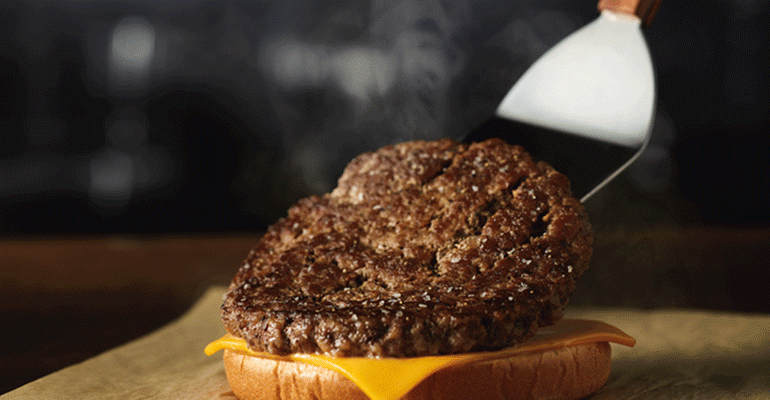McDonald’s Corp.’s announcement Thursday that, by mid-2018, it will start making Quarter Pounders to order using fresh beef represents one of the biggest operational changes in the company’s history.
How big? It took two years and a team of 40 people, including operators, supply chain representatives, marketing and culinary experts, to devise the processes that will make the change feasible across 14,000 restaurants.
“It’s a sea change for our system,” said Joe Jasper, a McDonald’s franchisee in the Dallas/Fort Worth area. “There were many things we needed to answer along the way. We wanted to make sure we dotted all the i’s and crossed all the t’s.”
Executives and franchisees with the Oak Brook, Ill.-based company hope that the change will do something they’ve struggled to do for much of the past four years: Sell more burgers.
McDonald’s has lost 500 million domestic transactions since 2012, most of them to the company’s primary competitors.
Through that time, breakfast has sold well, and in the fall of 2015 the chain began selling those breakfast items all-day — helping lead to a year’s worth of strong sales.
That sales bump suggests McDonald’s has been losing business at lunch and dinner, as more and more restaurant chains vie for the dining dollar. Indeed, at an event with analysts and investors earlier this month, executives vowed to improve the quality of the company’s product.
“We’re evaluating everything about core burger,” McDonald’s USA President Chris Kempczinski said at the event.

The change is the latest signal that McDonald’s is indeed willing to take aggressive steps to win back those 500 million transactions. The All-Day Breakfast introduction in the fall of 2015, for instance, upended a decades-long company edict that breakfast ends at 10:30 am.
Like that move, shifting to fresh beef requires a change in how the company operates.
“Both are quantum leaps in terms of retooling our processes,” Jasper said of all-day breakfast and the fresh beef move. “The all-day breakfast success from the consumer side speaks for itself.”
Currently, McDonald’s gets its patties frozen and prepares them in advance, keeping them in a warming bin until a customer places the order. Workers then put the sandwich together.
Instead, the company will use fresh beef for the larger, quarter-pound patties, and will prepare them to order, so customers get a freshly made burger patty. (The regular cheeseburgers and Big Macs will continue to be made from frozen patties.)
Jasper said customer reaction in the company’s test market to the fresh beef change was swift and positive.
“They responded pretty well the moment they ate it.”
The challenge, however, is to make the patties to order without sacrificing McDonald’s speed. The company’s business model is based on its convenience. Its consumers don’t want to wait for their burgers — especially in the drive-thru, where two-thirds of its customers get their orders, and where mere seconds can lead to lost business.
“McDonald’s is all about convenience,” Lucy Brady, the Oak Brook, Ill.-based burger giant’s chief strategy officer, said at the analyst event.
Jasper would not reveal what strategies the company developed over the past two years to ensure that the patties could be made quick enough to satisfy the needs of the drive thru. But he suggested that the team cracked the code.
“It took us two years to solve the process,” he said. “Without giving away trade secrets, we were able to solve that puzzle.”
To be sure, numerous restaurant chains — notably key McDonald’s competitor The Wendy’s Co. — have long used fresh beef. Wendy’s in particular has been hitting McDonald’s over the use of frozen patties recently.
While McDonald’s could solve some of the quality image problem by making frozen patties to order, Jasper believes the fresh beef makes a big difference.
“If I offered my customers our existing sandwich hot off the grill, they would love it,” he said. “But there’s something to a customer, when you put fresh beef on a premium sandwich, it really goes together well.”
Jasper said there are “some small changes to the beef,” the way it is sourced, made and housed in the restaurant. “It’s incredibly juicy, and it’s incredibly hot,” he said.
There’s another potential benefit for the chain: It could help boost sales of the company’s Signature Crafted burger line expected to come out later this year.
McDonald’s has long struggled with its premium burger — it killed its Angus third-pound burger line in 2013, four years after its much-ballyhooed introduction.
Yet Jasper believes that making fresh patties to order will give that Signature line more credibility with consumers.
“I know it will,” he said. “I’m quite confident this is one of the most important things we’ll do to help brand the signature line as an appropriate line for people on the go.”
“I’ll be quite surprised if it’s not a big, win-win situation,” he added.
Contact Jonathan Maze at [email protected]
Follow him on Twitter: @jonathanmaze





